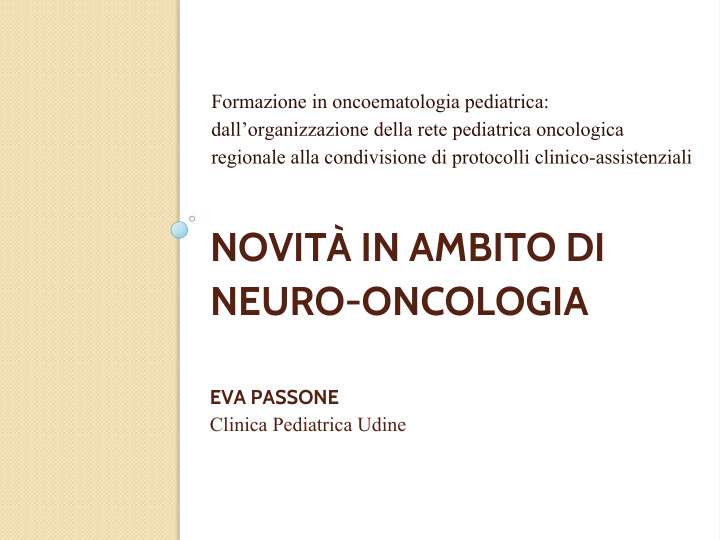



Formazione in oncoematologia pediatrica: dall’organizzazione della rete pediatrica oncologica regionale alla condivisione di protocolli clinico-assistenziali NOVITÀ IN AMBITO DI NEURO-ONCOLOGIA EVA PASSONE Clinica Pediatrica Udine
Classificazione WHO 2007 2016
PASSATO PRESENTE Sede Come in passato Caratteristiche istopatologiche + ● Grado (I-IV) ● Cellula di origine Caratteristiche biologiche
Classificazione WHO 2016
Classificazione WHO 2016
Differenze classificative
Classificazione WHO 2016
Most Common Brain and CNS Tumors by Age CBTRUS Statistical Report: NPCR and SEER Data from 2004-2006 Age Most common Second most histology common histology 0-4 Embryonal/ Pilocytic medulloblastoma astrocytoma 5-9 Pilocytic Malignant glioma, astrocytoma NOS 10-14 Pilocytic Neuronal/glial astrocytoma 15-19 Pituitary Pilocytic astrocytoma CBTRUS, Central Brain Tumor Registry of the United States
REVISIONE CENTRALIZZATA ISTOLOGIA PROGETTO PENSIERO
DIAGNOSI TC standardizzazione RMN 1.5 T-3T SPETTROSCOPIA PET CENTRALIZZAZIONE
FOLLOW UP IN TRATTAMENTO Criteri di Macdonald RANO RAPNO
Registro dei Tumori Infantili del Piemonte 1970-2005 Bambini 0-14 anni Sopravvivenza cumulativa (CS) per tumori SNC
Protocolli PASSATO PRESENTE Medulloblastoma Medulloblastoma Ependimoma Ependimoma Gliomi di basso grado Gliomi di basso grado
Medulloblastoma
Medulloblastoma HIT-SIOP PNET IV SIOP PNET 5 MB Medulloblastoma >3-5 Medulloblastoma >3-5 anni anni M0 < 16 anni per LR Resezione < 1.5 cm 2 < 22 anni per SR M0 Resezione < 1.5 cm 2 Unica modalità di trattamento 4 categorie con differenti protocolli di terapia
Medulloblastoma AN INTERNATIONAL PROSPECTIVE TRIAL ON MEDULLOBLASTOMA IN CHILDREN OLDER THAN 3 TO 5 YEARS WITH WNT BIOLOGICAL PROFILE (PNET 5 MB – LR and PNET 5 MB – WNT-HR), AVERAGE-RISK BIOLOGICAL PROFILE (PNET 5 MB -SR), OR TP53 MUTATION AND REGISTRY FOR MB OCCURRING IN THE CONTEXT OF GENETIC PREDISPOSITION ● PNET 5 MB-LR ● PNET 5 MB-SR ● PNET 5 MB-WNT HR ● PNET 5 MB SHH-TP53
Ependimoma
Gliomi di basso grado
Gliomi di basso grado
Gliomi di basso grado
Gliomi di basso grado SIOP LGG 2004 FUTURO??
SIOP LGG 2004
Terapia CHIRURGIA fondamentale Radioterapia ETA’ Chemioterapia: RUOLO?
Chirurgia ● Impatto prognostico ● Metodiche ● Sede ● Effetti collaterali
DIPG
Radioterapia Clinical trial designs generally include one or more hypotheses that address the following radiation oncology tenets: (1) Reduce the RT target volume to decrease side effects without affecting the rate of local tumor control or pattern of failure. (2) Concurrently administer chemotherapy and RT to improve disease control with acceptable treatment-related toxicity in patients with high-risk malignancies. (3) Individualize the treatment of children with specific malignancies on the basis of prior trial results and prognostic factors to include or eliminate RT or reduce radiation doses. (4) The distribution of radiation dose to an at-risk organ will correlate with that organ’s functional outcome. Pediatr Blood Cancer. 2013 June ; 60(6): 1037–1043. Children’s Oncology Group’s 2013 Blueprint for Research: Radiation Oncology Thomas E. Merchant, DO, PhD1,*, David Hodgson, MD, MPH2, Nadia N.I. Laack, MD, MS3, Suzanne Wolden, MD4, Danny J. Indelicato, MD5, and John A. Kalapurakal, MD6 on behalf of the COG Radiation Oncology Discipline Committee
Protonterapia
Palliative care
Effetti collaterali LUNGO TERMINE BREVE TERMINE Complicanze post-operatorie SFP
Neurotoxic effects, often referred to as “late effects,” are thought to fully manifest between 2 and 5 years after completion of treatment and are often associated with pronounced and chronic impairment. Late effects may occur in a variety of domains, including physical, medical, social, emotional, behavioral, and neurocognitive functioning it is estimated that 40%-100% of pediatric brain tumor survivors experience deficits in cognitive function related to the tumor and/or its treatment. Armstrong GT, Liu Q, Yasui Y, et al: Long-term outcomes among adult survivors of childhood central nervous system malignancies in the childhood cancer survivor study. J Natl Cancer Inst 101:946-958, 2009 Moore BD 3rd: Neurocognitive outcomes in Turner CD, Chordas CA, Liptak CC, et al: Medical, psychological, cognitive and survivors of childhood cancer. J Pediatr Psychol educational late-effects in pediatric low-grade glioma survivors treated with surgery only. 30:51-63, 2005 Pediatr Blood Cancer 53:417-423, 2009
Survivors were also found to perform poorly on measures of attention, memory, executive function, processing speed, psychomotor skills, visual-spatial skills, and language
Recommend
More recommend